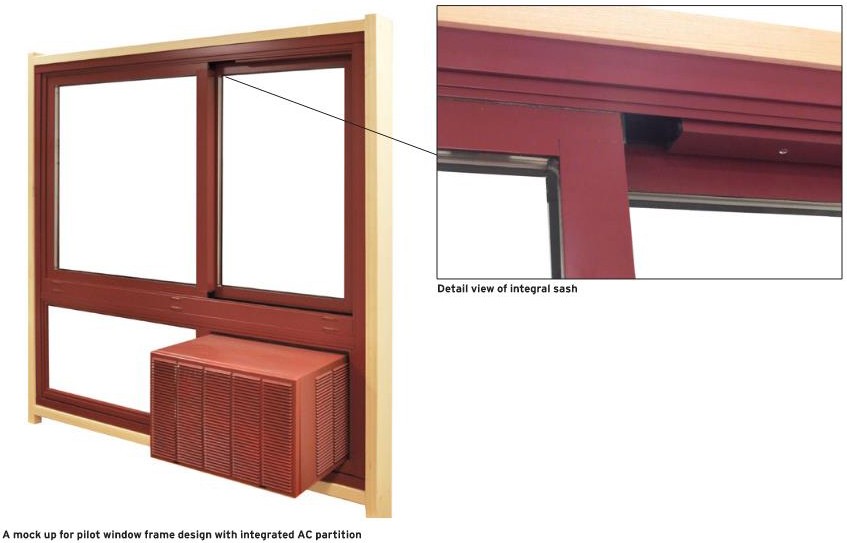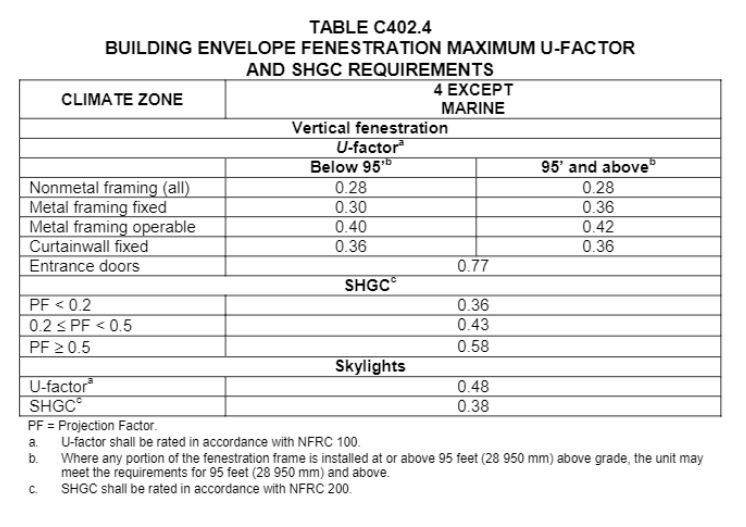Windows
Description
- High-quality, energy-efficient windows can play a significant part of a well-designed building envelope by reducing energy costs and improving indoor comfort by minimizing drafts and temperature fluctuations. AES recommends low-E glass with a low Solar Heat Gain Coefficient (SHGC) on south and southwest facing windows. Heat gain and heat loss through windows are responsible for 25%–30% of residential heating and cooling energy use (DOE). Windows insulative qualities are rated by U-Value, which is the inverse of R-value, and the U-Value is determined by the New York city Energy conservation Code. Selection should include the highest ENERGY STAR and National Fenestration Council (NFRC) ratings that is within the budget; while also ensuring they are durable, easy to maintain and have handles and locks that are easily reachable and operable by all residents, including those with mobility challenges. Hardware should not have sharp edges and screws should be tamper-proof.
- Window replacement may also require repair of lintels and surrounding brickwork and scaffolding / sidewalk sheds, see Building Exterior, Masonry section and Scaffolding section.
- Window replacement may involve environmental abatement.
Baseline
- The Architectural & Engineering Services office (AES) recommends sliding and casement windows in living rooms/bedrooms, casement windows in kitchens/bathrooms, and double-hung windows in bathrooms where the window is located at the shower or tub.
- In some instances a combination of a fixed and operable sash is acceptable.
- The color of windows, doors, and louvers located on lower floors must match the color of the existing lower-floor windows, doors, and louvers.
- Integral sash stops are required for the safety of children. Window operating forces, heights, and other accessibility factors must comply with Federal, State, and City codes.
- Energy Efficiency – NYCHA uses thermally broken aluminum frames. AES recommends baked enamel over an anodized aluminum finish. However, some manufacturers have obtained prior DOB approval for alternate materials, and this is permissible.
- Glazing must meet NYC Energy Conservation Code (NYCECC) and the Enterprise Green Community (EGC) NYC Overlay. Low-emissivity (Low-e) coatings or films must be used to improve solar and thermal performance without compromising the amount of visible light transmitted.
- NYCHA buildings fall under Commercial Buildings as per the NYECC and must follow those requirements for U-value.
- The installation detail must be air-sealed as per NYCECC.
- Many NYCHA windows fall under the requirements of Commercial buildings
- Window-mounted Air-Conditioners – NYCHA receives numerous citations for improper window AC installations, which causes tremendous financial waste and organizational inefficiency. Details should consider a thermally broken window AC partition that makes installation and removal easy and code compliant. For buildings with through-wall AC sleeves, rehabilitation should ensure the sleeves are air-sealed.
- Air-Conditioners – Installation should be coordinated with Mechanical discipline.
Stretch
- Propose and price an exterior or window-integrated shading strategy. [COMPMOD]
- Options include but are not limited to fins, louvers, brise soleil, external frame sunshades, shutters, screens, or other façade treatment, or between-the-glass shades.
RAD Conversion
- Replace all windows with high-performance, thermally-broken, double-pane, double-hung windows with insulated glazing units (IGU). Owner-provided window treatments (blinds) should be assumed and insect screens should be provided where residents request them. Minimum energy performance specifications are as follows:
- Maximum U value: 0.3
- SHGC: 0.30 – 0.60
- Maximum infiltration rate: 0.3 CFM/SF at 75pa when tested in accordance with ASTM E2357 and ASTM E783
- Minimum NFRC Condensation Resistance Rating: 50
- Materials: Aluminum, Fiberglass or other material satisfying the requirements above.
- Additional improvements may include:
- Replace all windows with high-performance, thermally-broken casement windows with Low-E insulated glazing units (IGU).
- Install an exterior or window-integrated shading system. Options include but are not limited to fins, louvers, brise soleil, external-frame sunshades, shutters, screens, or other façade treatment, or between-the-glass shades.
- Exterior shading systems that are mechanically fastened to the building façade are preferred for buildings that are not candidates for Historic Tax Credits or already National Register eligible or listed. If an interior shading strategy is specified (window blinds or similar), identify a strategy and budget for maintenance and replacement, and include assumptions for solar heat gain mitigation as compared to an exterior system.
Strategies

Promote Safety and Security of Residents & Staff

Optimize Performance, Operation & Maintenance of Buildings, Systems & Assets

Innovate Adaptive & Resilient Solutions
Last Updated on May 8, 2025 at 2:51 pm



















